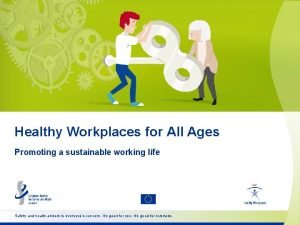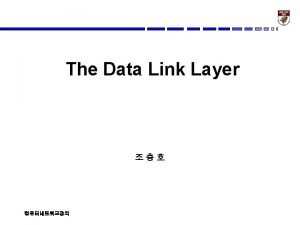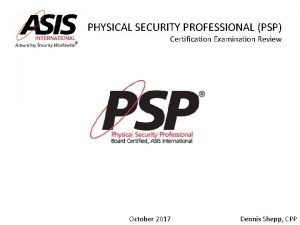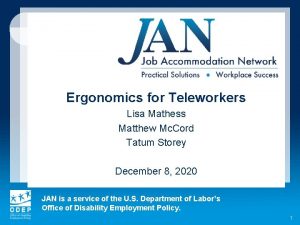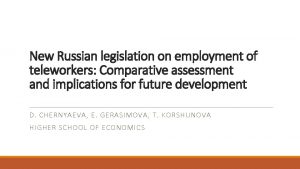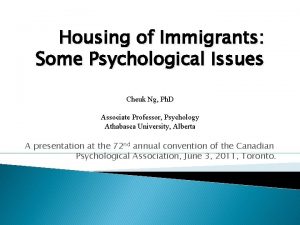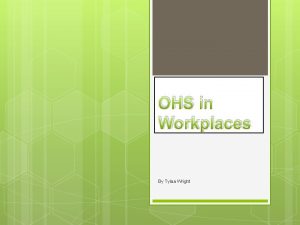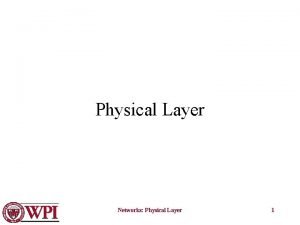Physical Workplaces of Teleworkers Cheuk F Ng Ph















- Slides: 15

Physical Workplaces of Teleworkers Cheuk F. Ng, Ph. D Centre for Psychology Athabasca University, Canada A presentation at the 41 th Conference of the Environmental Design Research Association, Washington, DC, June 2, 2010

Teleworking Overview n Popular but stabilized (Felstead et a. , 2005; Nilles, 2007; Moos & Skaburskis, n Definitions 2008), (Akyeampong, 2007) (Nilles; 1975; Kurland Bailey, 1999; Sullivan, 2003; -- use of ICT; employment status; employment contract; location -- forms/spectrum Haddon & Brynin, 2005) n Potential benefits and drawbacks claims -- society -- organizations: cost savings in facilities (Felstead et al. , 2005) -- employees (e. g. , reviews by Bailey & Kurland, 2002; Pinsonneault & Boisvert, 2001)

Physical Workspaces of Teleworkers Employee n Home-offices -- 89% home-based teleworkers, 54% of whom employees (Telework America Survey, 2000); Statistics Canada; Finnish study Organizational n n Corporate office Satellite offices Other/Public n n n Telework/Neighborhood centres/ tele-cottages Clients’ worksites Public -- “Third places”, “transitional space”, etc.

Benefits/Drawbacks for Employees n 1. Potential benefits Greater autonomy, more flexibility in work schedule n Potential drawbacks 1. Increased family-work role conflicts 2. Better balance between personal, family, and work life 3. Higher perceived productivity and quality of work 4. Comfortable work environment at home Lower perceived personal growth and career advancement Professional and social isolation; lower collegiality and sense of belonging 4. Over-working because of lack of separation between work and family domains 5. Inadequate work environment at home; occupational and health issues; costs in running home office References: reviews by Bailey & Kurland, 2002; Pinsonneault & Boisvert, 2001)

Home Office: Research Overview n home-workers’ workspace (who includes teleworkers) (e. g. , Ahrentzen, 1989, 1990; Gurstein, 1991, 1996, 2001; Magee, 2000; Mahmood, 2007; Zavotka & Timmons, 1996) -- small samples -- varied greatly in occupation, use of ICT, external contacts, employment status, employment contract, extent of working form home -- used in-depth interviews, time diaries, photographs, physical observation n Teleworker surveys (e. g. , Golden et al. , 2006; Hill et al. , 1998; Nilles, 2000) -- larger samples -- not focused on spatial aspects of home workspace

Home-Office Effectiveness n Extensive research on conventional office environment: Layout & design associated with work behaviors (c. f. , reviews Mc. Coy, 2002; Rashid & Zimming, 2005; Sundstrom, 1987; Vischer, 2005, etc. ) n Variables important in intersection between family/non-work domain (demand; social support) and work domain (social & physical environment; job/task characteristics; organizational characteristics) Standen et al. , 1999) n (Hone et al. , 1998; Distance work characteristics: office/home time, information technology, internal contact, external contact, knowledge intensity (Standen et al. , 1999)

Conventional Office Reviews: The layout and design of conventional office environment associated with various work behaviors, job satisfaction, and wellbeing n n n Influences of ambient features, spatial arrangements, selfidentity and status, communication, privacy on performance and job satisfaction (Sundstrom, 1987) Interact with the physical environment: Control; Functional opportunities; Non-verbal expression Respond to spatial organization, architectonic details, views, resources, ambient properties (Mc. Coy, 2002) “Space Does Matter”: Performance, comfort, territory (Vischer, 2002)

De Croon et al. ’s conceptual framework (2005) Office Concepts Location Layout Use Short-term Reaction Long-term reaction Physiological Psychological Health Performance Work Conditions Job demands Job resources Source: de Croon et al. (2005). The effect of office concepts on worker health and performance: A systematic review of the literature, Ergonomics, 48(2), 119 -134.

The Home Office n Size Location n Layout n Use – n n n -- Open plan or private Fixed or sharing/ segmentation to integration Ambient features: Job equipment noise & music; lighting

Work Conditions n Job Demands -- Cognitive workload: -- Working hours n ------ (de Croon et al. ’s model) distractions/interruptions Job Resources Communication Work autonomy and control Privacy: visual, acoustical, information access Territory Interpersonal relationships

Other Issues n Financial: -- costs of equipment, furnishings, maintenance -- “rent”, renovation n Legal: -- occupational health and safety: “control”, “ownership” of worksite -- workers compensation

Conclusions n n n Few studies of design/physical conditions of home offices of home-based teleworkers Homeworkers (including teleworkers) seem to desire similar qualities as they desire for the workspace in their corporate office + away from private area and noises within home Current dwellings are not designed for paid work. Activity conflicts have implications for design of homes (Gurstein, 2001).

Further Research Questions n n What makes an effective home workspace for teleworkers? What are the effects of involuntary teleworking, especially when their home environment may not be suitable? What impact does full-time teleworking on home workspace, work behaviors and job outcomes? What are the influences of organizational support, teleworkers’ characteristics and job requirements on home workspace?

Further Research Questions n What are the effects of family type, life stage, composition and activity pattern on home workspace? n What are the negotiation and decision-making processes within the family of the teleworker? (Ahrentzen, 1987; Moore, 2001) n How does use of mobile technologies influences work at home? n What innovative planning and design of homes can suit teleworker and family’s needs? (Gurstein, 2001) n How does ambient conditions of different physical work setting (e. g. , coffee shops) influence the performance of online tasks?

Thank You! n n n Key References Ng, C. F. (2010). Teleworker's home office: An extension of corporate office? Facilities, 28(3/4), 137 -155. (a special issue on Environment Behavior in Facilities Management). Ng, C. F. (2006). Academics telecommuting in open and distance education universities: Issues, challenges and opportunities. International Review of Research in Open and Distance Learning, 7(2). Available at: http: //www. irrodl. org/index. php/irrodl/article/view/300/632
 Healthy workplaces for all ages
Healthy workplaces for all ages Healthy workplaces campaign
Healthy workplaces campaign Physical rate fences
Physical rate fences Physical fitness grade 9
Physical fitness grade 9 Venn diagram of geometric optics and physical optics
Venn diagram of geometric optics and physical optics Geography of the middle colonies
Geography of the middle colonies Oman relative location
Oman relative location Physical layer coding violations
Physical layer coding violations Outline physical map of africa
Outline physical map of africa Sawing wood chemical or physical change
Sawing wood chemical or physical change Physical security professional (psp)
Physical security professional (psp) Physical interaction design
Physical interaction design Way of life that involves little physical activity
Way of life that involves little physical activity Hertz cpu
Hertz cpu Efficient synonym
Efficient synonym Mixing red and green marbles physical change
Mixing red and green marbles physical change
